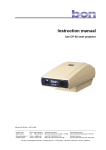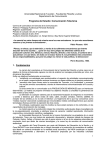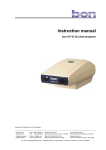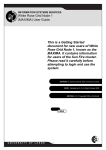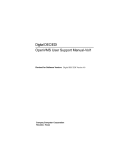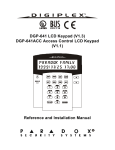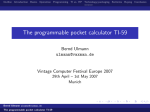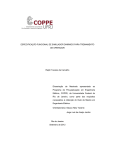Download Here - vaxman.de
Transcript
Installing (and running) BSD 2.11 on a PDP11 Dr. Bernd Ulmann December 28, 2011 1 Introduction For my lectures Operating Systems Theory/Practice I wanted to have a historic UNIX system up and running for demonstration purposes. Since I managed to build a Frankenstein-PDP11 made from pieces out of various junk bins, it seemed logical to install a BSD UNIX on this machine, namely BSD 2.11. This document describes the installation procedure (which is outlined in way more detail in the official installation and user’s guide [2.11BSD]). Since a real ts tape drive is quite slow and since I already have a simh emulator up and running on my Mac, I decided to perform the installation of the BSD distribution kit on the emulator and then transfer the disk image to a real disk connected to the real PDP11. A wealth of information and help has been obtained from http://www.retrocmp. com/how-tos/installing-211bsd-unix-on-pdp-1144 which describes the process of getting BSD 2.11 up and running on a PDP11/44. 2 2.1 Installation Booting from tape First of all start the emulator (the path name shown is valid only for my local installation): alberich$ ../../simh/pdp11 PDP-11 simulator V3.8-1 sim> set tto 7b sim> set ts enable sim> set cpu 3072k Disabling CR Disabling RK Disabling HK Disabling TM sim> set rq0 ra92 sim> attach ts media/211bsd.tap attach rq0 media/ra92.dsk sim> RQ: creating new file sim> boot ts 73Boot from ts(0,0,0) at 0172522 1 2.2 Disklabel Since I am lucky to have SCSI controller for the PDP11 I decided to use a rather large disk and settled for the RA92 implementation of simh. The first thing that is necessary is loading the disklabel program from tape and perform the necessary disk partitioning magic: : ts(0,1) Boot: bootdev=01001 bootcsr=0172522 disklabel Disk? ra(0,0) ’ra(0,0)’ is unlabeled or the label is corrupt. Proceed? [y/n] y d(isplay) D(efault) m(odify) w(rite) q(uit)? D d(isplay) D(efault) m(odify) w(rite) q(uit)? d type: MSCP disk: RA92 label: DEFAULT flags: bytes/sector: 512 sectors/track: 73 tracks/cylinder: 13 sectors/cylinder: 949 cylinders: 3099 rpm: 3600 drivedata: 0 0 0 0 0 1 partitions: # size a: 2940951 0 offset 2.11BSD fstype [fsize bsize] 1024 1024 # (Cyl. 0 - 3098) Now we have a RA92 disk with one partition named a that spans over the whole disk. This disk now needs a label – it will be named SNOOPY since that is the PDP11’s name: d(isplay) D(efault) m(odify) w(rite) q(uit)? m modify d(isplay) g(eometry) m(isc) p(artitions) q(uit)? m modify misc d(isplay) t(ype) n(ame) l(abel) f(lags) r(pm) D(rivedata) q(uit)? l label [DEFAULT]: SNOOPY modify misc d(isplay) t(ype) n(ame) l(abel) f(lags) r(pm) D(rivedata) q(uit)? q modify d(isplay) g(eometry) m(isc) p(artitions) q(uit)? d type: MSCP disk: RA92 label: SNOOPY flags: bytes/sector: 512 sectors/track: 73 tracks/cylinder: 13 2 sectors/cylinder: 949 cylinders: 3099 rpm: 3600 drivedata: 0 0 0 0 0 1 partitions: # size a: 2940951 0 offset 2.11BSD fstype [fsize bsize] 1024 1024 # (Cyl. 0 - 3098) modify Having now a disk with a label, we will need additional partitions for the core system, swapping etc. First of all we will change the partition a to be 100 MB in size: d(isplay) g(eometry) m(isc) p(artitions) q(uit)? p modify partitions d(isplay) n(umber) s(elect) q(uit)? s a b c d e f g h q(uit)? a sizes and offsets may be given as sectors, cylinders or cylinders plus sectors: 6200, 32c, 19c10s respectively modify partition ’a’ d(isplay) z(ero) t(ype) o(ffset) s(ize) f(rag) F(size) q(uit)? s ’a’ size [2940951]: 204800 modify partition ’a’ d(isplay) z(ero) t(ype) o(ffset) s(ize) f(rag) F(size) q(uit)? q modify partitions d(isplay) n(umber) s(elect) q(uit)? d type: MSCP disk: RA92 label: SNOOPY flags: bytes/sector: 512 sectors/track: 73 tracks/cylinder: 13 sectors/cylinder: 949 cylinders: 3099 rpm: 3600 drivedata: 0 0 0 0 0 1 partitions: # size a: 204800 0 offset 2.11BSD fstype [fsize bsize] 1024 1024 # (Cyl. 0 - 215*) modify partitions Now we need another partition, b, for swapping. This partition starts where partition a ends and will be 16 MB in size (a bit generous but having a disk as large as a RA92 this should not be a problem): d(isplay) n(umber) s(elect) q(uit)? s a b c d e f g h q(uit)? b 3 sizes and offsets may be given as sectors, cylinders or cylinders plus sectors: 6200, 32c, 19c10s respectively modify partition ’b’ d(isplay) z(ero) t(ype) o(ffset) s(ize) f(rag) F(size) q(uit)? ’b’ offset [0]: 204800 modify partition ’b’ d(isplay) z(ero) t(ype) o(ffset) s(ize) f(rag) F(size) q(uit)? ’b’ size [0]: 32768 modify partition ’b’ d(isplay) z(ero) t(ype) o(ffset) s(ize) f(rag) F(size) q(uit)? ’b’ fstype [unused]: swap modify partition ’b’ d(isplay) z(ero) t(ype) o(ffset) s(ize) f(rag) F(size) q(uit)? modify partitions d(isplay) n(umber) s(elect) q(uit)? d o s t q type: MSCP disk: RA92 label: SNOOPY flags: bytes/sector: 512 sectors/track: 73 tracks/cylinder: 13 sectors/cylinder: 949 cylinders: 3099 rpm: 3600 drivedata: 0 0 0 0 0 2 partitions: # size offset a: 204800 0 2.11BSD b: 32768 204800 swap fstype [fsize bsize] 1024 1024 # (Cyl. 0 - 215*) # (Cyl. 215*- 250*) modify partitions The next partition will be named c and covers the whole disk: d(isplay) n(umber) s(elect) q(uit)? s a b c d e f g h q(uit)? c sizes and offsets may be given as sectors, cylinders or cylinders plus sectors: 6200, 32c, 19c10s respectively modify partition ’c’ d(isplay) z(ero) t(ype) o(ffset) s(ize) f(rag) F(size) q(uit)? ’c’ offset [0]: modify partition ’c’ d(isplay) z(ero) t(ype) o(ffset) s(ize) f(rag) F(size) q(uit)? ’c’ size [0]: 2940951 modify partition ’c’ d(isplay) z(ero) t(ype) o(ffset) s(ize) f(rag) F(size) q(uit)? ’c’ fstype [unused]: modify partition ’c’ d(isplay) z(ero) t(ype) o(ffset) s(ize) f(rag) F(size) q(uit)? modify partitions d(isplay) n(umber) s(elect) q(uit)? d 4 o s t q type: MSCP disk: RA92 label: SNOOPY flags: bytes/sector: 512 sectors/track: 73 tracks/cylinder: 13 sectors/cylinder: 949 cylinders: 3099 rpm: 3600 drivedata: 0 0 0 0 0 3 partitions: # size offset a: 204800 0 2.11BSD b: 32768 204800 swap c: 2940951 0 unused fstype [fsize 1024 1024 # # 1024 1024 # bsize] (Cyl. 0 - 215*) (Cyl. 215*- 250*) (Cyl. 0 - 3098) modify partitions The next partition, g, will cover the remaining space of the drive – please note that the partition type has to be set to 2.11BSD: d(isplay) n(umber) s(elect) q(uit)? s a b c d e f g h q(uit)? g sizes and offsets may be given as sectors, cylinders or cylinders plus sectors: 6200, 32c, 19c10s respectively modify partition ’g’ d(isplay) z(ero) t(ype) o(ffset) s(ize) f(rag) F(size) q(uit)? ’g’ offset [0]: 237568 modify partition ’g’ d(isplay) z(ero) t(ype) o(ffset) s(ize) f(rag) F(size) q(uit)? ’g’ size [0]: 2703383 modify partition ’g’ d(isplay) z(ero) t(ype) o(ffset) s(ize) f(rag) F(size) q(uit)? ’g’ fstype [unused]: 2.11BSD modify partition ’g’ d(isplay) z(ero) t(ype) o(ffset) s(ize) f(rag) F(size) q(uit)? modify partitions d(isplay) n(umber) s(elect) q(uit)? d type: MSCP disk: RA92 label: SNOOPY flags: bytes/sector: 512 sectors/track: 73 tracks/cylinder: 13 sectors/cylinder: 949 cylinders: 3099 rpm: 3600 drivedata: 0 0 0 0 0 5 o s t q 7 partitions: # size offset fstype [fsize a: 204800 0 2.11BSD 1024 1024 # b: 32768 204800 swap # c: 2940951 0 unused 1024 1024 # g: 2703383 237568 2.11BSD 1024 1024 bsize] (Cyl. 0 - 215*) (Cyl. 215*- 250*) (Cyl. 0 - 3098) # (Cyl. 250*- 3098*) modify partitions Now we are finished and can write the changes we did back to the disk: d(isplay) g(eometry) m(isc) p(artitions) q(uit)? q d(isplay) D(efault) m(odify) w(rite) q(uit)? w d(isplay) D(efault) m(odify) w(rite) q(uit)? q 73Boot from ts(0,0,1) at 0172522 : 2.3 Creating and populating the root filesystem After we have set up the system disk we can now create an empty root filesystem: : ts(0,2) Boot: bootdev=01002 bootcsr=0172522 Mkfs file system: ra(0,0) file sys size [102400]: bytes per inode [4096]: interleaving factor (m; 2 default): interleaving modulus (n; 474 default): isize = 25600 m/n = 2 474 Exit called 73Boot from ts(0,0,2) at 0172522 : The next step is to copy the root filesystem image from tape to disk: : ts(0,3) Boot: bootdev=01003 bootcsr=0172522 Restor Tape? ts(0,5) Disk? ra(0,0) Last chance before scribbling on disk. End of tape 73Boot from ts(0,0,3) at 0172522 : 2.4 Booting UNIX for the 1st time Now we can boot the newly installed BSD image for the 1st time by loading the standalone boot program from ra(0,0): 6 : ra(0,0)unix Boot: bootdev=02400 bootcsr=0172150 2.11 BSD UNIX #115: Sat Apr 22 19:07:25 PDT 2000 [email protected]:/usr/src/sys/GENERIC ra0: Ver 3 mod 3 ra0: RA92 size=2940951 phys mem = 3145728 avail mem = 2921792 user mem = 307200 June 8 21:21:24 init: configure system hk ? csr 177440 vector 210 skipped: No CSR. ht ? csr 172440 vector 224 skipped: No CSR. ra 0 csr 172150 vector 154 vectorset attached rl 0 csr 174400 vector 160 attached tm ? csr 172520 vector 224 does not exist. tms 0 csr 174500 vector 260 vectorset attached ts 0 csr 172520 vector 224 attached xp 0 csr 176700 vector 254 attached erase, kill ^U, intr ^C # Since the disk is currently not bootable we have to copy the proper bootstrap into block 0. All available bootstraps are located in /mdec – since we are using a RA92 disk drive, we need rauboot which contains the ra driver (be sure to use the raw device of the destination disk): # ls -la /mdec total 16 drwxr-xr-x 2 root 512 Apr 23 2000 drwxr-xr-x 14 root 512 Apr 23 2000 -r--r--r-- 1 root 512 Dec 5 1995 -r--r--r-- 1 root 512 Dec 5 1995 -r--r--r-- 1 root 512 Dec 5 1995 -r--r--r-- 1 root 512 Dec 5 1995 -r--r--r-- 1 root 512 Dec 5 1995 -r--r--r-- 1 root 512 Dec 5 1995 -r--r--r-- 1 root 512 Dec 5 1995 -r--r--r-- 1 root 512 Dec 5 1995 -r--r--r-- 1 root 512 Dec 5 1995 -r--r--r-- 1 root 512 Dec 5 1995 -r--r--r-- 1 root 512 Dec 5 1995 -r--r--r-- 1 root 512 Dec 5 1995 -r--r--r-- 1 root 512 Dec 5 1995 -r--r--r-- 1 root 512 Dec 5 1995 # dd if=/mdec/rauboot of=/dev/rra0a count=1 1+0 records in 1+0 records out # 7 . .. bruboot dvhpuboot hkuboot hpuboot rauboot rkuboot rluboot rm03uboot rm05uboot rx01uboot rx02uboot si51uboot si94uboot si95uboot We can now stop the simulator by pressing CTRL-E and boot from the newly created system disk: Simulation stopped, PC: 004376 (MOV (SP)+,177776) sim> b rq0 73Boot from ra(0,0,0) at 0172150 : ra(0,0,0)unix Boot: bootdev=02400 bootcsr=0172150 2.11 BSD UNIX #115: Sat Apr 22 19:07:25 PDT 2000 [email protected]:/usr/src/sys/GENERIC ra0: Ver 3 mod 3 ra0: RA92 size=2940951 phys mem = 3145728 avail mem = 2921792 user mem = 307200 June 8 21:21:24 init: configure system hk ? csr 177440 vector 210 skipped: No CSR. ht ? csr 172440 vector 224 skipped: No CSR. ra 0 csr 172150 vector 154 vectorset attached rl 0 csr 174400 vector 160 attached tm ? csr 172520 vector 224 does not exist. tms 0 csr 174500 vector 260 vectorset attached ts 0 csr 172520 vector 224 attached xp 0 csr 176700 vector 254 attached erase, kill ^U, intr ^C # 2.5 Setting up /usr Now we can proceed to setup the basic system: # date 1112261655 date: can’t write wtmp file. Mon Dec 26 16:55:00 PST 2011 # passwd root Changing password for root. New password: Retype new password: # hostname snoopy To setup the /usr filesystem we have to create a new filesystem in partition g and populate this filesystem with the contents of the save file on tape after mounting the partition on /usr: # newfs ra0g newfs: /sbin/mkfs -m 2 -n 474 -i 4096 -s 1351691 /dev/rra0g isize = 65488 8 m/n = 2 474 # mount /dev/ra0g /usr But first we have to create new device files for the ts tape drive: # # # # cd /dev rm *mt* ./MAKEDEV ts0 sync We can now, finally, start to copy the contents of /usr from tape to the newly mounted partition g: # # # # cd /usr mt rew mt fsf 6 tar xpbf 20 /dev/rmt12 The next tape file contains the sources of the kernel and all necessary include files which will be restored to /usr/src (the mt command positions the tape to the beginning of the next tape file): # # # # mkdir src cd src mt -f /dev/rmt12 fsf tar xpbf 20 /dev/rmt12 We are nearing the end of the installation by now. The next step is to set the file protections on some central directories and create a symbolic link to the system sources: # # # # cd / chmod 755 / /usr /usr/src /usr/src/sys rm -f sys ln -s /usr/src/sys sys Due to an acute paranoia attack we will check the file system integrity of partition g of the system disk: # umount /dev/ra0g # fsck /dev/rra0g ** /dev/rra0g File System: /usr NEED SCRATCH FILE (332 BLKS) ENTER FILENAME: /tmp/usrfsck ** Last Mounted on /usr ** Phase 1 - Check Blocks and Sizes ** Phase 2 - Check Pathnames ** Phase 3 - Check Connectivity ** Phase 4 - Check Reference Counts ** Phase 5 - Check Free List 5139 files, 38744 used, 1308852 free 9 Everything seems to be correct, so we will remount /usr and add a line to /etc/fstab to make sure /usr will be mounted automatically during system startup: # mount /dev/ra0g /usr # cd /etc # echo "/dev/ra0g # cat fstab /dev/ra0a / /dev/ra0b none /dev/ra0g /usr # /usr ufs ufs swap ufs rw sw rw rw 1 1 0 1 1" >> fstab 1 0 1 We will now halt the BSD system and make a copy of the disk container file – just to make sure we have a good checkpoint in case something goes wrong: # halt syncing disks... done halting HALT instruction, PC: 000014 (MOV #1,17406) sim> quit alberich$ cp media/ra92.dsk ra92.dsk_bare_system Now let us boot the system just assembled again (starting the emulator as shown in section 2.1): sim> b rq0 73Boot from ra(0,0,0) at 0172150 : ra(0,0,0)unix Boot: bootdev=02400 bootcsr=0172150 2.11 BSD UNIX #115: Sat Apr 22 19:07:25 PDT 2000 [email protected]:/usr/src/sys/GENERIC ra0: Ver 3 mod 3 ra0: RA92 size=2940951 phys mem = 3145728 avail mem = 2921792 user mem = 307200 December 26 17:19:10 init: configure system hk ? csr 177440 vector 210 skipped: No CSR. ht ? csr 172440 vector 224 skipped: No CSR. ra 0 csr 172150 vector 154 vectorset attached rl 0 csr 174400 vector 160 attached tm ? csr 172520 vector 224 does not exist. tms 0 csr 174500 vector 260 vectorset attached ts 0 csr 172520 vector 224 attached xp 0 csr 176700 vector 254 attached erase, kill ^U, intr ^C # 10 To leave the single user mode just press CTRL-D – the boot process will continue: Fast boot ... skipping disk checks checking quotas: done. Assuming non-networking system ... checking for core dump... preserving editor files clearing /tmp standard daemons: update cron accounting. starting lpd starting local daemons: sendmail. Mon Dec 26 17:19:16 PST 2011 2.11 BSD UNIX (curly.2bsd.com) (console) login: root Password: erase, kill ^U, intr ^C # The tape image that comes with BSD 2.11 (instead of a real distribution on tapes which spans two tapes) contains the sources of all commands etc. in the last file on the tape. To extract these sources we will proceed as follows: First position the tape to the right file, then change the directory to /usr/src and extract the tape archive file’s contents before finally stopping the system and ending the PDP11 emulation: # mt fsf 8 # cd /usr/src # tar xpb 20 # halt syncing disks... done halting HALT instruction, PC: 000014 (MOV #1,17406) sim> quit Goodbye alberich$ 3 Configuring the system The next big task to accomplish is the configuration of the system – this involves building a new kernel to include support for the devices of the target system, most notably the DELQA ethernet controller. 3.1 Compiling a new kernel Let us start the emulator and boot the image just created again: alberich$ ../../simh/pdp11 PDP-11 simulator V3.8-1 11 sim> set tto 7b sim> cd cpu 3072k Unknown command sim> set cpu 3072k Disabling CR Disabling RK Disabling HK Disabling TM sim> set rq0 ra92 sim> attach rq0 media/ra92.dsk sim> boot rq0 73Boot from ra(0,0,0) at 0172150 : ra(0,0,0)unix Boot: bootdev=02400 bootcsr=0172150 2.11 BSD UNIX #115: Sat Apr 22 19:07:25 PDT 2000 [email protected]:/usr/src/sys/GENERIC ra0: Ver 3 mod 3 ra0: RA92 size=2940951 phys mem = 3145728 avail mem = 2921792 user mem = 307200 December 26 17:29:37 init: configure system hk ? csr 177440 vector 210 skipped: No CSR. ht ? csr 172440 vector 224 skipped: No CSR. ra 0 csr 172150 vector 154 vectorset attached rl 0 csr 174400 vector 160 attached tm ? csr 172520 vector 224 skipped: No CSR. tms 0 csr 174500 vector 260 vectorset attached ts ? csr 172520 vector 224 skipped: No CSR. xp 0 csr 176700 vector 254 attached erase, kill ^U, intr ^C # cd /usr/src/sys/conf /usr/src/sys/conf: bad directory # Fast boot ... skipping disk checks checking quotas: done. Assuming non-networking system ... checking for core dump... preserving editor files clearing /tmp standard daemons: update cron accounting. starting lpd starting local daemons: sendmail. Mon Dec 26 17:31:42 PST 2011 2.11 BSD UNIX (curly.2bsd.com) (console) login: root 12 Board M8061 Emulex M7516 3rd party M7957 Emulex Device RL controller TS tape controller DELQA RX02 controller DZV11 terminal multiplexer Dual SCSI controller CSR address 774400 772520 774440 777170 760100 772150 760354 Vector 160 224 120 264 300 154 310 Table 1: Device configuration of the PDP11 Password: erase, kill ^U, intr ^C # The machine has also an EMULEX SCSI controller card, a DZV11 terminal multiplexer1 and a DELQA ethernet controller etc. The overall configuration is shown in table 1. We will now create a new configuration file for the new kernel to be built. These configuration files are found in /usr/src/sys/conf – we will make a copy of GENERIC, name it SNOOPY and perform the necessary changes to that file: # cd /usr/src/sys/conf # cp GENERIC SNOOPY These things have to be changed: • Set LINEHZ to 50 instead of 60, reflecting the European line frequency. • Set PDP to 73 instead of GENERIC since this represents our system. • Set IDENT to SNOOPY and MAXUSERS to 8. • The filesystem configuration is a bit more tricky – since we use a MSCP device (a SCSI disk on an Emulex controller) we have to change the variables PIPEDEV, ROOTDEV and SWAPDEV accordingly. Therefore the offset of the ra driver in the bdevsw table in the file /usr/src/sys/pdp/conf.c is necessary. This number is 5, so we will set PIPEDEV and ROOTDEV to makedev(5,0) and SWAPDEV to makedev(5,1). • The only change in the kernel configuration is setting SOFUB MAP to 0 since we do not need a software UNIBUS/QBUS map that would allow us to use 18 bit controllers in a 22 bit QBUS system2 . • Next we will configure the available disk drives: Set NBR to 0, NHK to 0, NRAC to 2, NRAD to 4, NRK to 0, NRL to 2, NRX to 2 and NSI, NXPC, NXPD, NRAM to 0. • Configuring the tape drives: Set NHT, NTM to 0, set AVIVTM to NO, set NTS to 1 (this is our TS11 tape drive), set NTMSCP and NTMS to 0, leave TMSCP DEBUG set to 0. 1 According to [LSI-11 SSM][Appendix B, p. 1125], the DZV11 is the QBUS analog of the UNIBUS DZ11. 2 This parameter is set to YES for the GENERIC kernel. 13 • Now for the terminals: Leave NKL, the number of DL11s, set to 13 , set NDZ to 14 . • To configure network support, set INET to YES and NETHER to 1. The GENERIC kernel does not need any pseudo terminals but since some applications require them we will create 10 pseudo terminals5 by setting NPTY to 10. To support our DELQA ethernet controller, we set NQE to 1i6 . Having created a new configuration file named SNOOPY like this we can no compile a new kernel for the system: # ./config SNOOPY Creating ../SNOOPY. Copying standard files to ../SNOOPY. Setting configuration options for SNOOPY. Creating device header files. Creating Makefile for SNOOPY. # cd /sys/SNOOPY # make The make command produces lots of output (and it is really a good idea to run all of this on the emulator instead of a real PDP11 since this operation takes ages on a real PDP11 :-) ). The only problem is that this kernel build will fail since the linker will be unable to pack everything we requested into the address space available on a PDP11 (64 kB minus 8 kB used for IO space): ld -q -r -d -X -i -o unix.o scb.o ld: too big for type 431 *** Exit 2 mch_backup.o mch_click.o ... Stop. # The type 431 denotes a split I/D space with overlays – a BSD 2.11 kernel for a PDP11 requires split I/D space and overlays, so this is OK7 . Let us have a detailed look at unix.o: # size unix.o text data bss dec hex 58880 6828 24450 90158 1602e total text: 110208 overlays: 7744,7360,7872,7296,2240,8384,4864,5568 # Now it is getting a bit messy: The address space of a PDP11 is 64 kB of which 8 kB are reserved for IO devices. How does BSD 2.11 handle a kernel larger than the remaining 56 kB (including all necessary data structures)? It uses overlays of 8 kB each, so the idea is to have a base segment being 48 kB in size with various overlays containing the modules that did not fit into the base segment. Getting the 3 The console terminal is a DL11. our the DZV11 only supports four instead of eight serial lines. 5 Note that each PTY requires 78 bytes in the kernel data space! 6 Althoughi NQT might seem more appropriate, it is for a late DELQA only. 7 There is a great news article describing this problem and its solution in detail: http://www.dnull.com/bsd/oldnews/bsdnew62161.html. 4 Although 14 base segment below 48 kB is simple – just move modules to an overlay segment (as long as they fit). This is done in the Makefile. The section starting with BASE= contains the list of all modules that go into the base segment. Following this section are up to 15 overlay segments OV1 to OV15. Please note that no overlay segment may be empty except the last ones! After some severe fiddling with Makefile the relevant portions look like this: BASE= br.o clock.o cons.o dh.o dhu.o dhv.o dr.o dz.o hk.o ht.o init_sysent.o \ kern_clock.o kern_descrip.o kern_mman.o kern_proc.o kern_prot.o \ kern_prot2.o kern_subr.o kern_synch.o lp.o machdep.o ra.o ram.o \ rk.o rl.o rx.o si.o subr_rmap.o sys_inode.o sys_kern.o \ tm.o ts.o tty.o tty_conf.o tty_subr.o tty_tb.o \ ufs_bmap.o ufs_inode.o kern_xxx.o subr_xxx.o \ vm_proc.o vm_sched.o vm_swap.o xp.o quota_subr.o OV1= sys_generic.o ufs_syscalls.o vfs_vnops.o OV2= kern_acct.o kern_exec.o kern_exit.o kern_fork.o kern_resource.o OV3= kern_time.o sys_process.o ufs_mount.o ufs_subr.o uipc_syscalls.o OV4= dkbad.o kern_sig.o mem.o trap.o tty_pty.o tty_tty.o OV5= quota_kern.o quota_ufs.o quota_sys.o \ sys_pipe.o OV6= ufs_disksubr.o ufs_dsort.o ufs_syscalls2.o kern_sig2.o OV7= mch_fpsim.o kern_sysctl.o ingreslock.o vm_text.o OV8= ufs_bio.o ufs_namei.o # OV9 gets the (hopefully) never used routines OV9= dn.o init_main.o kern_pdp.o machdep2.o subr_prf.o syscalls.o \ subr_log.o vm_swp.o OV10= tmscp.o tmscpdump.o toy.o ufs_alloc.o ufs_fio.o Running make again works fine now: # make ... ... ... ... size unix text data bss dec hex 50048 6830 24450 81328 13db0 total text: 110528 overlays: 7744,7360,7872,7232,1344,4864,5568,8000,7872,2624 Compacting symbol table symcompact unix symcompact: 252 symbols removed Compacting strings table strcompact unix rearranging symbols symorder ../pdp/symbols.sort unix ./checksys unix System will occupy 200992 bytes of memory (including buffers and clists). end nproc text ninode callout ram_size namecache ld -X -i -o netnix {0075060} nbuf {0015214} buf {0015202} proc {0060760} ntext {0074020} nfile {0015210} file {0015206} inode {0015400} ncallout {0037010} ucb_clist {0015220} nclist {0000000} xitdesc {0015376} quotdesc {0046742} _iosize {0014036} nlog net_copy.o net_csv.o net_mbuf.o net_scb.o ... 15 {0047244} {0015204} {0071364} {0015212} {0015216} {0000000} {0014510} size netnix text data bss dec hex 59776 2314 38906 100996 18a84 Compacting symbol table symcompact netnix symcompact: 247 symbols removed Compacting strings table - this will take a few minutes strcompact netnix rearranging symbols symorder ../pdp/symbols.sort netnix # Now let us save the old kernel (just in case we messed up), install the new one and reboot the system to test it: # cp /unix /oldunix # make install install -c -o root -g kmem -m 744 unix /unix install -c -o root -g kmem -m 744 netnix /netnix # halt syncing disks... done halting HALT instruction, PC: 000014 (MOV #1,17406) sim> b rq0 73Boot from ra(0,0,0) at 0172150 : ra(0,0,0)unix Boot: bootdev=02400 bootcsr=0172150 2.11 BSD UNIX #26: Mon Dec 26 19:10:23 PST 2011 [email protected]:/usr/src/sys/SNOOPY ra0: Ver 3 mod 3 ra0: RA92 size=2940951 attaching qe0 csr 174440 qt@174440 !-YM attaching lo0 phys mem = 3145728 avail mem = 2808384 user mem = 307200 December 26 19:13:36 init: configure system hk ? csr 177440 vector 210 skipped: ht ? csr 172440 vector 224 skipped: ra 0 csr 172150 vector 154 vectorset rl 0 csr 174400 vector 160 attached tm ? csr 172520 vector 224 skipped: tms ? csr 174500 vector 260 skipped: ts ? csr 172520 vector 224 skipped: xp ? csr 176700 vector 254 skipped: erase, kill ^U, intr ^C 16 No autoconfig routines. No autoconfig routines. attached No autoconfig routines. No autoconfig routines. No CSR. No autoconfig routines. # Fast boot ... skipping disk checks checking quotas: done. Assuming NETWORKING system ... ifconfig: ioctl (SIOCGIFFLAGS): no such interface add host curly.2bsd.com: gateway localhost.2bsd.com add net default: gateway 206.139.202.1: Network is unreachable starting system logger Dec 26 19:14:01 curly vmunix: ra0: Ver 3 mod 3 Dec 26 19:14:01 curly vmunix: ra0: RA92 size=2940951 checking for core dump... preserving editor files clearing /tmp standard daemons: update cron accounting. starting network daemons: inetd rwhod printer. starting local daemons: sendmail. Mon Dec 26 19:14:01 PST 2011 Dec 26 19:14:01 curly December 26 19:14:01 init: kernel security level changed from 0 to 1 2.11 BSD UNIX (curly.2bsd.com) (console) login: root Password: erase, kill ^U, intr ^C # 3.2 Devices. . . The next step involves the creation of devices for our current kernel: # cd /dev # ./MAKEDEV std local ra0 ra1 ra2 ra2 mt0 nmt0 rl0 rl1 pty0 rz0 Now make sure that the CSR- and VEC-addresses of the devices configured in the system are correct. These settings are done in /etc/dtab. The only things which have to be changed here are the lines for the dz terminal multiplexer and the rx floppy controller which have to be activated by removing the comment character in column 1. In addition to that the entry for the ethernet controller (qe) has to be activated and its VEC address has to be changed from 400 to 120. To avoid unnecessary warnings during system startup, the entries for hk, kt, tm and tms have been disabled by commenting them out. In addition to that /etc/MAKEDEV.local has to be adapted to the current environment. Most notably we have to make sure that the swap device is linked to the correct partition, in this case to /dev/ra0b: rm -f swap; chgrp kmem swap chmod 640 swap ln ra0b swap Also, we should perform a cd /etc; ./MAKEDEV kmem. 17 3.3 Configuring the network Edit /etc/hosts to suit the local environment: 127.0.0.1 192.168.31.16 192.168.31.62 localhost.2bsd.com localhost.arpa localhost fafner.pi-research.de fafner snoopy.pi-research.de snoopy . . . and adapt /etc/netstart accordingly by changing the variable hostname to contain the value snoopy.pi-research.de. In addition to that /etc/printcap has to be edited, too (I just removed any entries by commenting them out). One should also not forget to adapt /etc/ntp.conf. 4 Getting it to the real PDP11 Now we have to copy the disk image to a real disk and attach this to the destination system, the Frankenstein PDP11 which is shown in figure 1. This machine is really ugly but fast – and it is a bit strange: Obviously it is a QBUS machine in a BA23 enclosure but the CPU card is from a PDP11/84 (unfortunately that was the only thing I could save from scrap from this 11/84 – I found it on the office wall of someone who found this board to pretty to be scrapped – this previous owner one day gave it to me), so the machine thinks it is a PDP11/84 (with FPU chip, by the way!) while it is in fact a QBUS machine. The top drawer contains a RX02 compatible diskette drive, followed by a Cipher front loading tape drive, the CPU enclosure and two RL02 disk drives (10MB each)8 . 4.1 Writing the image to a real disk The only other system that is currently running having a SCSI controller is FAFNER, my VAX 7000/820, so copying the disk image contaning the BSD 2.11 UNIX involves the following steps: 1. Transfer the image to the VAX using ftp9 . 2. Copy the image to a foreign mounted disk. alberich$ ftp fafner Connected to fafner. 220 fafner.pi-research.de FTP Server (Version 5.3) Ready. Name (fafner:ulmann): 331 Username ulmann requires a Password Password: cd bast230 User logged in. Remote system type is VMS. ftp> cd bastel 250-CWD command successful. 250 New default directory is DISK$USER_0:[ULMANN.BASTEL] ftp> bin 200 TYPE set to IMAGE. ftp> put ra92.dsk 8 As you will have realized the rack is as much non-DEC as possible – it is from an old Honeywell installation and was the only empty rack I had at home when I started to put this PDP11 together from the various parts described. 9 Using a NFS share would be more elegant but the NFS server of TCPIP 5.3 is too buggy to attempt a transfer as large as this. 18 Figure 1: The destination system – a QBUS PDP11 that thinks it is a PDP11/84 19 local: ra92.dsk remote: ra92.dsk 229 Entering Extended Passive Mode (|||61798|) 150 Opening data connection for DISK$USER_0:[ULMANN.BASTEL]RA92.DSK; (192.168.31.18,60363) 226 Transfer complete. 1505682432 bytes sent in 46:31 (526.75 KB/s) ftp> bye 221 Goodbye. alberich$ telnet fafner Trying 192.168.31.16... Connected to fafner. Escape character is ’^]’. Username: system Password: Welcome to OpenVMS VAX V7.2 Last interactive login on Monday, 26-DEC-2011 17:46 Last non-interactive login on Monday, 26-DEC-2011 17:46 SYSTEM:FAFNER$ mou/for $1$dka4 %MOUNT-I-MOUNTED, SCRATCH mounted on _$1$DKA4: (HSJ0) SYSTEM:FAFNER$ copy/log disk$user_0:[ulmann.bastel]ra92.dsk $1$dka4: %COPY-S-COPIED, DISK$USER_0:[ULMANN.BASTEL]RA92.DSK;1 copied to $1$DKA4:[]RA92.D SK;1 (2940786 blocks) SYSTEM:FAFNER$ dism $1$dka4 SYSTEM:FAFNER$ lo Connection closed by foreign host.C-2011 19:27:11.67 alberich$ This disk is then (physically) transfered to the PDP11. Here is the log of the first boot on the real machine: Testing in progress - Please wait Memory Size is 4088 K Bytes 9 Step memory test Step 1 2 3 4 5 6 7 8 9 Message 04 Entering Dialog mode Commands are Help, Boot, List, Setup, Map and Test. Type a command then press the RETURN key: B DU0 Trying DU0 Starting system from DU0 83Boot from ra(0,0,0) at 0172150 : ra(0,0,0)unix Boot: bootdev=02400 bootcsr=0172150 2.11 BSD UNIX #26: Mon Dec 26 19:10:23 PST 2011 [email protected]:/usr/src/sys/SNOOPY 20 ra0: Ver 5 mod 13 ra0: RA81 size=4110393 attaching qe0 csr 174440 qt@174440 !Turbo attaching lo0 phys mem = 4186112 avail mem = 3848768 user mem = 307200 December 26 20:57:51 init: configure system dz 0 csr 160100 vector 310 attached ra 0 csr 172150 vector 154 vectorset attached rl 0 csr 174400 vector 160 attached rx 0 csr 177170 vector 264 attached ts 0 csr 172520 vector 224 attached qe ? csr 174440 vector 120 skipped: No autoconfig routines. erase, kill ^U, intr ^C # Fast boot ... skipping disk checks checking quotas: done. /dev/swap: Operation not supported by device Assuming NETWORKING system ... add host snoopy.pi-research.de: gateway localhost.2bsd.com add net default: gateway 192.168.31.254 starting system logger checking for core dump... Dec 26 20:59:06 snoopy vmunix: ra0: Ver 5 mod 13 Dec 26 20:59:06 snoopy vmunix: ra0: RA81 size=4110393 preserving editor files clearing /tmp standard daemons: update cron accounting. starting network daemons: inetd rwhod printer. starting local daemons: sendmail. Mon Dec 26 20:59:24 PST 2011 Dec 26 20:59:25 snoopy December 26 20:59:25 init: kernel security level changed from 0 to 1 2.11 BSD UNIX (snoopy.pi-research.de) (console) login: root Password: erase, kill ^U, intr ^C # We now have a BSD 2.11 UNIX up and running on a real PDP1110 . 10 Oh dear – I had almost forgotten how slow a real PDP11 is, compared with simh on a modern multi GHz processor, but there is nothing to compete with a real PDP11! :-) 21 5 Final configuration tasks Now that the BSD 2.11 is happily running on a real PDP11 there are a few things left to do11 which will be described in the following. 5.1 Serial lines Since this particular PDP11 has a DZV11 quad terminal interface and since I do not want to use modem control12 the terminal devices have to be created by hand: # # # # # cd /etc mknod tty00 mknod tty01 mknod tty02 mknod tty03 c c c c 2 2 2 2 128 129 130 131 The trick are the minor device numbers which normally would have been 0 to 3 for these four asynchronous lines. Setting bit 7 turns on soft carrier, so these devices won’t wait for a Carrier-Detect signal to respond to. To enable these serial lines for logins, /etc/ttys must be edited to contain the following lines: tty00 tty01 tty02 tty03 5.2 "/usr/libexec/getty "/usr/libexec/getty "/usr/libexec/getty "/usr/libexec/getty std.9600" std.9600" std.9600" std.9600" vt100 vt100 vt100 vt100 on on on on secure secure secure secure User accounts Setting up users on such a historic UNIX is quite straight forward. All that has to be done is to add an entry to /etc/master.passwd, copy this file to /etc/passwd, transform this into a valid passwd file and create a home directory. All users will belong to the group staff which has the GID 10, and UIDs will start at 100. So first add the following line to /etc/master.passwd: ulmann::100:10::::Bernd Ulmann:/usr/home/ulmann:/bin/sh No perform the copy, create a home directory etc. – the last step has to be done only once, of course: # # # # # # cp master.passwd passwd mkpasswd passwd mkdir -p /usr/home/ulmann chgrp staff /usr/home/ulmann chown ulmann /usr/home/ulmann chmod a+r /usr/home This newly created user can now login without password – a password should be set immediately using the passwd command. If the user should be able to perform a su, the file /etc/group has to be adapted like this: wheel:*:0:root,ulmann 11 Thanks for http://www.retrocmp.com/how-tos/installing-211bsd-unix-on-pdp-1144/ for a lot of valuable hints! :-) 12 Modem control can be a real problem – without a proper Carrier-Detected signal no connection will be established and I want to use the four serial lines with simple three wire connections. . . 22 References [2.11BSD] Stevan Schultz, Installing and Operating 2.11BSD on the PDP-11, June 13, 1995 [LSI-11 SSM] DEC, LSI-11 Systems Service Manual, three volumes, 5th edition, 1985 23
























